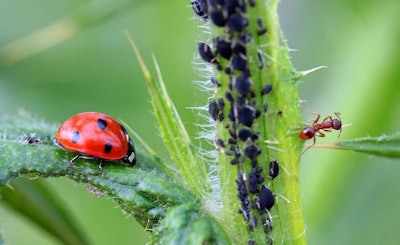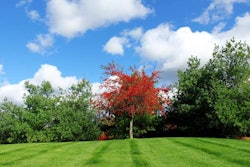
Large numbers of aphids can weaken sensitive plants and cause leaf stunting, yellowing, and curling. Certain types of aphids can transmit plant viruses or cause distorted plant growth with their toxic saliva. Late spring is when most kinds of aphids cause the greatest damage.
These small insects can be green, gray, yellow, bright red, and even black. They can form large masses thanks to almost all aphids being female. These females give live birth to a genetically identical daughter via asexual reproduction. They can give birth to three to five young per day.
Sometimes the main issue with aphids is not plant injury but their production of honeydew, which attracts ants, flies, hornets, and yellow jackets. Honeydew is sticky and can cover any surface that is beneath infested plant material. It also promotes the growth of sooty mold, which further detracts from plant appearance.
Thankfully, there are multiple options when it comes to controlling and preventing aphid attacks.
Cultural
To reduce the likelihood of aphid attacks, take care not to over-fertilize your customer’s property as excess nitrogen promotes the new growth that aphids love. Slow-release fertilizers can feed plants at a more controlled rate. Another step to take is removing weeds like sowthistle or mustard, which can host large aphid colonies.
Growing plants such as alyssum, cilantro, hyssop, and other nectar-producing flowers can attract the beneficial bugs that feed on aphids. These natural enemies include ladybugs, lacewings, and parasitic wasps, but a number of other insects feed on the defenseless sap suckers as well.
It is important to control any ants that may be feeding on honeydew as they protect the aphids from predatory insects.
Birds are also connoisseurs of aphids, so creating a bird-friendly backyard to warblers, wrens, nuthatches, titmice and hummingbirds can also help reduce the pesky population of aphids.
Physical
One of the simplest ways to remove aphids from a plant is by spraying the plant with a jet of water from a hose. If dealing with seedlings, use a spray bottle instead. Hosing off plants can lethally injure aphids and those that survive struggle to find their host plant again. Spraying water can also help wash off honeydew or sooty mold that may have accumulated.
Seedlings can also be protected by using floating row covers. It is important to remember to remove the covers when the plants begin to flower.
Chemical
Because so many predatory insects are used to control aphids, chemical controls are suggested as a last resort as they kill a variety of insects, including the beneficial ones. If it is decided an insecticide is needed it is better to find a low-impact option that goes easy on natural enemies and pollinators.
Insecticidal soap and horticultural oils are useful control options if applied thoroughly. These must come in contact with the aphids’ bodies to be effective. The use of certain pesticides can injure your client’s plants so always check the label before applications. The chemical azadirachtin is a plant-based insecticide that causes insects to stop feeding and eventually die and has short residual effect.









